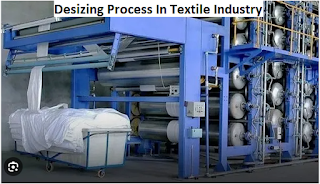Sizing Process In Weaving: Objectives, Functions, Types, Advantages and Disadvantages
Sizing Process
The method of applying gelatinous film-forming substance on warp is called sizing. Sizing is termed the "heart of weaving". Technically, it is the process of giving protective clothing on the warp yarn to minimize yarn breakage during weaving. Sizing is mainly done on woven fabrics Denim garments and terry towels.
Objectives of Sizing
- To help the fiber from abrasion to the head reed
- To improve the breaking strength of cellulosic fiber
- To improve the smoothness of yarn
- To improve the elasticity of yarn
- To decrease the hairiness of yarn
- To decrease the static electricity formation
Technical Changes Due to Sizing
- To increase abrasion resistance
- To increase the breading strength
- To increase the fiber smoothness
- To increase the elasticity
- To increase the actual dia
- To decrease the fiber hairiness
- To decrease the formation of static electricity
Sizing Process Flow Chart:
- Warping Beam
- Sizing
- Drying
- Leasing
- Weaver's Beam
Chemicals Used for Sizing Process
1. Adhesives:
- Function:
- It increases the breaking strength
- It increases the abrasion strength
- Example: Wheat flower, polyvinyl chloride, polyvinyl alcohol
2. Lubricant:
- Function:
- It increases the smoothness of fiber
- It increases the elasticity of fiber
- Examples: Mineral oil, Japanese wax, vegetable oil, coconut oil, etc.
3. Anticeptic Agent:
- Function:
- It helps to store the fiber without breakage
- It helps to protect the fiber from the attack of bacteria and fungus
- Example: Zinc chloride, phenol, etc
4. Deliquirecent Agent:
- Function:
- Prevent brittleness of sizing material
- Helps to keep standard moisture regain
- Example: Glycerine
5. Wetting Agent:
- Function:
- Helps to wet yarn instantly
- Example: MgCl2
6. Weighting Agent:
- Function:
- Helps to increase the weight of yarn
- Example: China clay, French chalk
7. Tinting Agent:
- Function:
- To increase the brightness of yarn
- Example: Blue
8. Anti-foaming Agent:
- Function:
- Helps to prevent foam formation
- Example: Benzene, pyridine.
Size Take-up or Pick-up Percentage:
The amount of size material added to the yarn is called size take-up or pick-up percentage.
Size take-up percentage = Wt. of sized yarn - Wt. of unsized yarn/Wt. of unsized yarn *100%
Drying System:
There are four types of drying systems,
1. Cylinder Drying
- Two cylinder drying
- Multi-cylinder drying
3. Infrared drying
4. Combined drying
Cylinder Drying
1. Two cylinder drying:
Merit: Easy process
Demerits:
- Slow process
- Insufficient drying
- Due to the sticking property of cylinder, the surface of the yarn may not be smooth
- The cost of the cylinder is high. So problem with any damage
2. Multi-cylinder drying:
Merits:
- Speedy process
- Uniform drying
- Non-sticky
- A process to give standard humidity and temperature
Demerits:
Merits: No external tension is applied on yarn, So, there is no possibility of dimension change
Demerits:
- Slow process
- Difficult to maintain temperature
- Insufficient drying
- Not economical
Infrared Drying
Merits: Quick process
Demerits:
- Costly process
- Probability of having an accident
- Difficult to maintain a uniform temperature
Combined Drying
Merits: High Speed
Demerits: Costly process
Ordinary Cooking/ Misizing:
- Add the required amount of water
- Add antiseptic while stirring
- Then starch and stir is added for 30-45 minutes
- Continue steaming until corrected viscosity is formed
- Stop steaming
- Add a pH of 6-8 by adding a certain amount of acid or alkalies.
- Transfer the size solution to the reverse tank and maintain temperature at 60 C
Disadvantages of Sizing:
- Cost of land and machine
- Labor cost
- Utility cost
- Cost of ingredients
- Long process
- Risk of degradation
- Increase of yarn dia
- Increase in yarn stiffness
- Increase of stiffness
- Increase of roughness
- Risk of pollution
- Loss of warp length of beam
Substitute of Sizing:
- Wrapped yarn
- Singled yarn
- High-quality yarn
- Ply yarn
- Modification of loom
Techniques of Sizing:
There are seven techniques of sizing in weaving process.
- Hot melt sizing
- Emulsion sizng
- Solvent sizing
- High-pressure sizing
- Electrostatic sizing
- Foam Sizing
- Combined sizing
Types of Sizing Size Take-Up Percentage
- Light sizing - 3-10%
- Pure sizing - 11-16%
- Medium sizing - 17-40%
- Heavy sizing - above 40%
Lights Sizing:
Light sizing can be used for dyeing and printing. In light sizing, 3-10 % size materials are used in the warp yarn.
Pure Sizing:
This type of sizing is done for unbleached fabric. In pure sizing, 11-16 % size material are used on the weight of the fabric.
Medium Sizing:
This type of sizing is used for increase of strength and weight. In medium sizing, 16- 40 % size pick percentage are used on the weight of the fabric.
Heavy Sizing:
This type of sizing is used for weight twisted and lower count yarn. In heavy sizing, Size pick percentage is above 40 % on the weight of the fabric




Comments
Post a Comment